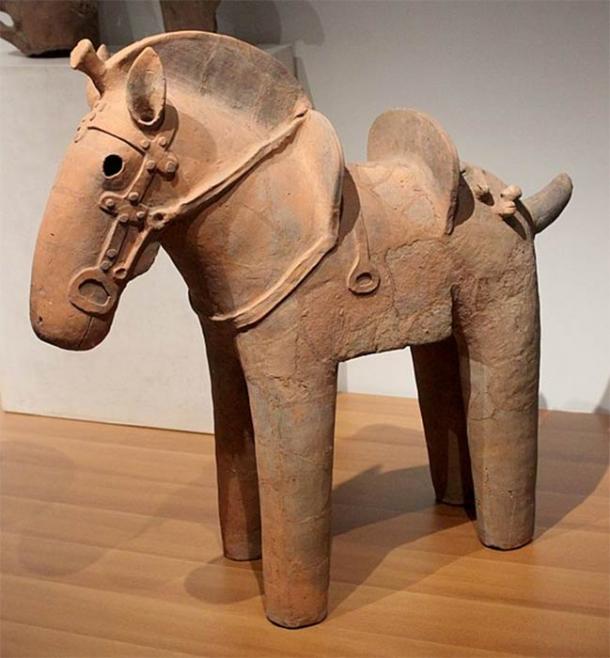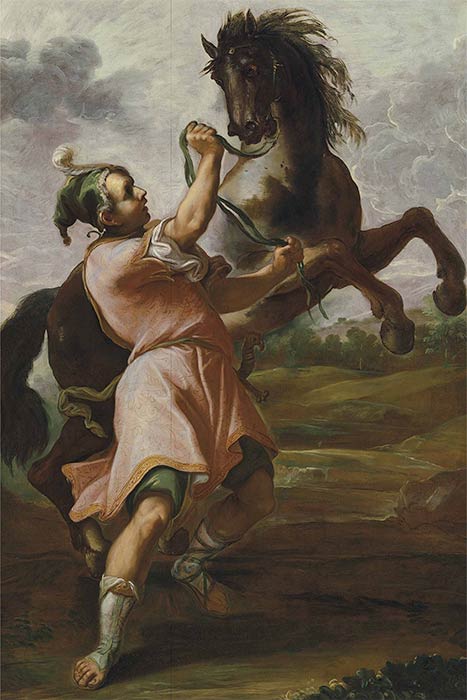Horses have lived on earth for more than 50 million years and they were first domesticated in Asia between 3000 and 4000 BC. According to the American Museum of Natural History at this time they were sought mostly for their rich milk and protein packed meat. Serving as one of man’s closest allies at work, during war and at play, over their 6,000 years of domestic history several equines have stood out for their legendary strength, speed and intelligence. These are the hardest, heavy-weight champions of the horse world, who each left their hoof print on history and stood the test of time like those legendary men who rode on their backs.

Haniwa horse statuette featuring saddle and stirrups from the sixth century Kofun period. Parí s, Mus ée Guimet.( Miguel Hermoso Cuesta / CC BY-SA 4.0 )
Bucephalus Beloved Of Alexander The Great
One of the most outstanding famous horses of antiquity is the steed of Alexander the Great, Bucephalus or Bucephalas, meaning ox head. Reported as a massive creature with a huge head and a blue eye, Bucephalus had a rich black coat with a large white star marked in the center of his brow. In 344 BC Plutarch, the Greek philosopher, biographer, essayist and priest at the Temple of Apollo, said “ at 12 or 13 years of age, Alexander of Macedonia won the horse by making a wager with his father” . The story goes that a horse dealer named Philonicus the Thessalian, had offered Bucephalus to the King Phillip II for 13 talents, which was an astronomical price for any horse, but because the animal was untamable the king was not interested, however, a young Alexander was.

Alexander and Bucephalus by Domenico Maria Canuti (1645 – 1684) ( Public Domain )
It is said that this was a skittish horse that would rear against anyone who came near it. It was only tamed when Alexander turned him toward the sun, putting his shadow behind him, the shadow of course representing the source of Bucephalus’ fears. According to Plutarch as Alexander returned to the arena with Bucephalus and dismounted, Phillip said, “O my son look thee out a kingdom equal to and worthy of thyself, for Macedonia is too little for thee .” Most historians agree that Alexander´s famous taming of the wild Bucephalus was the turning point in the young prince ’s life as this was the first time that the famous ruler demonstrated the required determination and confidence to ‘subjugate, tame and control’, qualities which were to become central deployments in his conquest of Asia.
Like this Preview and want to read on? You can! JOIN US THERE ( with easy, instant access ) and see what you’re missing!! All Premium articles are available in full, with immediate access.
For the price of a cup of coffee, you get this and all the other great benefits at Ancient Origins Premium. And – each time you support AO Premium, you support independent thought and writing.
Ashley Cowie is a Scottish historian, author and documentary filmmaker presenting original perspectives on historical problems, in accessible and exciting ways. His books, articles and television shows explore lost cultures and kingdoms, ancient crafts and artifacts, symbols and architecture, myths and legends telling thought-provoking stories which together offer insights into our shared social history . www.ashleycowie.com.
Top Image: The Battle of Little Bighorn, from the Indian side by Charles Marion Russell (1903) ( Public Domain)
By Ashley Cowie
Related posts:
Views: 0
 RSS Feed
RSS Feed

















 November 25th, 2020
November 25th, 2020  Awake Goy
Awake Goy 



 Posted in
Posted in  Tags:
Tags: 
















